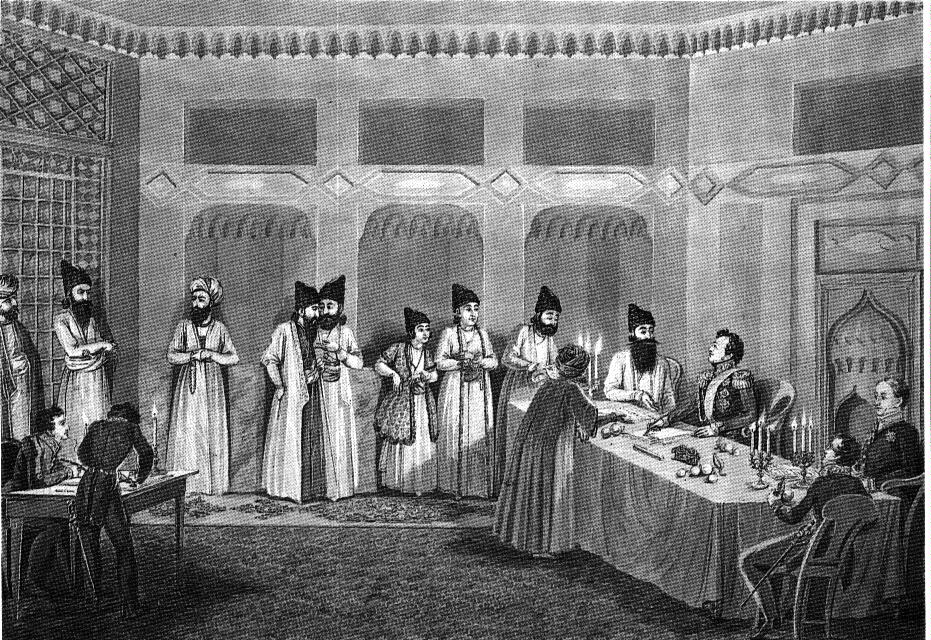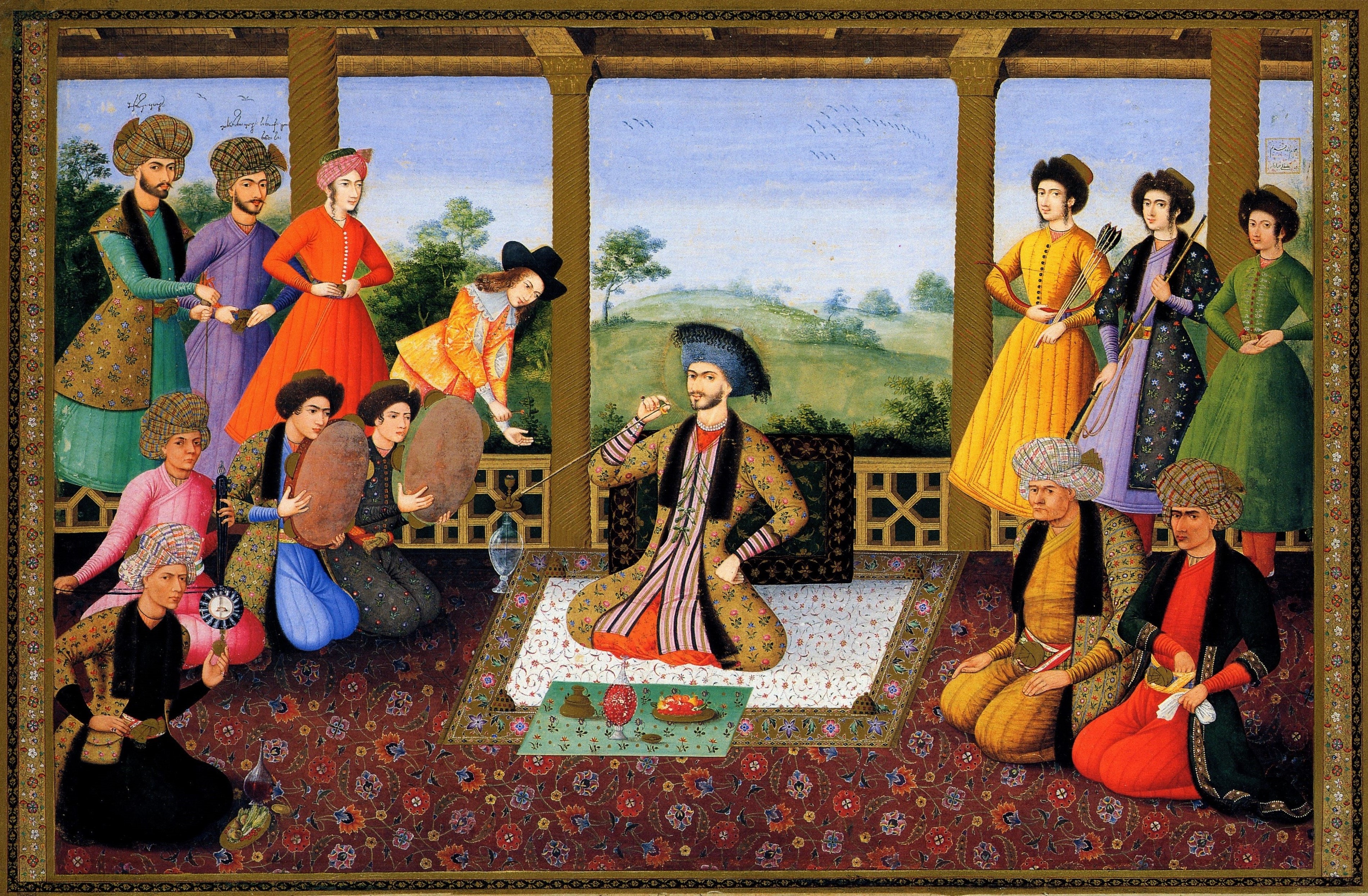|
Mohammad-Ali Mirza Dowlatshah
Mohammad-Ali Mirza Dowlatshah ( fa, محمدعلیمیرزا دولتشاه; 5 January 1789, in Nava – 22 November 1821, in Taq-e Gara) was a famous Iranian Prince of the Qajar dynasty. He is also the progenitor of the Dowlatshahi family of Persia. He was born at Nava, in Mazandaran, a Caspian province in the north of Iran. He was the first son of Fath-Ali Shah, the second Qajar king of Persia, and Ziba-Chehr Khanum, a Georgian girl of the Tsikarashvili (also spelled Tzicara Chwili) family. He was also the elder brother (by seven months) of Abbas Mirza. Dowlatshah was the governor of Fars at age 9, Qazvin and Gilan at age 11, Khuzestan and Lorestan at age 16, and Kermanshah at age 19. In the battles with Russia and Persia's archrival, the Ottoman Empire, he defeated the Ottomans in Baghdad and Basra, and crushed the Russians in Yerevan and Tbilisi. Dowlatshah developed and improved the city of Kermanshah and established the city of Dowlat-Abad which was renamed Malayer. D ... [...More Info...] [...Related Items...] OR: [Wikipedia] [Google] [Baidu] |
Taq-e Gara
Taq-e Gara or some times Taq-e Shirin is a stone structure in Iran which belonging to the Sasanian Empire. It is built in the Patagh Pass in the heights where is known as the Gate of Zagros in Kermanshah Province of Iran. This structure is located on the way from Kermanshah to Sarpol-e Zahab, on the 15th kilometer from Sarpol-e Zahab; beside an ancient paving which connects the Iranian Plateau to Mesopotamia. Due to changes of the path, now it is located below the road slope.https://www.visitiran.ir/fa/attraction/%D8%AA%D8%A7%D9%82-%DA%AF%D8%B1%D8%A7 Design and construction There are conflicting views as to the time of its construction. Parthian and Sassanid eras have been proposed, but most archeologists and historians believe that it has been built during late Sassanid Empire for a variety of reasons. Access and attributes The monument is located on the old road from Kermanshah to Qasr-e Shirin with the new road overlooking it. It is about a five hundred meters walk away from ... [...More Info...] [...Related Items...] OR: [Wikipedia] [Google] [Baidu] |
Northern Iran
Northern Iran consists of the southern border of the Caspian Sea and the Alborz mountains. It includes the provinces of Gilan, Mazandaran, and Golestan. (Ancient kingdom of Hyrcania, medieval region of Tabaristan). The major provinces, Gilan and Mazandaran, are covered with dense forests, snow-covered mountains and impressive sea shores. The major cities are Rasht, Gorgan, Sâri, Bâbol, Amol, Qaem Shahr, Gonbad-e Kavus, Anzali, and Lahijan. Northern Iran has numerous villages, particularly Massulé, appreciated by travellers. Northern Iran was a trendy spot during the Pahlavi era, especially among foreign tourists. It was a luxurious place that provided all types of modern recreational facilities as well as tourism infrastructure. Today, it's mostly visited by domestic tourists. Language Iran is a very diverse country. "Dialect wise" there are different sub-languages and dialects of native speakers in the north of Iran as well the rest of the country. From the east ... [...More Info...] [...Related Items...] OR: [Wikipedia] [Google] [Baidu] |
Neva, Mazandaran
Neva ( fa, نوا, also Romanized as Nevā and Navā) is a village in Bala Larijan Rural District, Larijan District, Amol County, Mazandaran Province, Iran. At the 2006 census, its population was 185, in 48 families. References Populated places in Amol County {{Amol-geo-stub ... [...More Info...] [...Related Items...] OR: [Wikipedia] [Google] [Baidu] |
Polish Language
Polish (Polish: ''język polski'', , ''polszczyzna'' or simply ''polski'', ) is a West Slavic language of the Lechitic group written in the Latin script. It is spoken primarily in Poland and serves as the native language of the Poles. In addition to being the official language of Poland, it is also used by the Polish diaspora. There are over 50 million Polish speakers around the world. It ranks as the sixth most-spoken among languages of the European Union. Polish is subdivided into regional dialects and maintains strict T–V distinction pronouns, honorifics, and various forms of formalities when addressing individuals. The traditional 32-letter Polish alphabet has nine additions (''ą'', ''ć'', ''ę'', ''ł'', ''ń'', ''ó'', ''ś'', ''ź'', ''ż'') to the letters of the basic 26-letter Latin alphabet, while removing three (x, q, v). Those three letters are at times included in an extended 35-letter alphabet, although they are not used in native words. The traditional ... [...More Info...] [...Related Items...] OR: [Wikipedia] [Google] [Baidu] |
French Language
French ( or ) is a Romance language of the Indo-European family. It descended from the Vulgar Latin of the Roman Empire, as did all Romance languages. French evolved from Gallo-Romance, the Latin spoken in Gaul, and more specifically in Northern Gaul. Its closest relatives are the other langues d'oïl—languages historically spoken in northern France and in southern Belgium, which French ( Francien) largely supplanted. French was also influenced by native Celtic languages of Northern Roman Gaul like Gallia Belgica and by the ( Germanic) Frankish language of the post-Roman Frankish invaders. Today, owing to France's past overseas expansion, there are numerous French-based creole languages, most notably Haitian Creole. A French-speaking person or nation may be referred to as Francophone in both English and French. French is an official language in 29 countries across multiple continents, most of which are members of the ''Organisation internationale de la Francophonie'' ... [...More Info...] [...Related Items...] OR: [Wikipedia] [Google] [Baidu] |
English Language
English is a West Germanic language of the Indo-European language family, with its earliest forms spoken by the inhabitants of early medieval England. It is named after the Angles, one of the ancient Germanic peoples that migrated to the island of Great Britain. Existing on a dialect continuum with Scots, and then closest related to the Low Saxon and Frisian languages, English is genealogically West Germanic. However, its vocabulary is also distinctively influenced by dialects of France (about 29% of Modern English words) and Latin (also about 29%), plus some grammar and a small amount of core vocabulary influenced by Old Norse (a North Germanic language). Speakers of English are called Anglophones. The earliest forms of English, collectively known as Old English, evolved from a group of West Germanic (Ingvaeonic) dialects brought to Great Britain by Anglo-Saxon settlers in the 5th century and further mutated by Norse-speaking Viking settlers starting in the 8th and 9th ... [...More Info...] [...Related Items...] OR: [Wikipedia] [Google] [Baidu] |
Tbilisi
Tbilisi ( ; ka, თბილისი ), in some languages still known by its pre-1936 name Tiflis ( ), is the Capital city, capital and the List of cities and towns in Georgia (country), largest city of Georgia (country), Georgia, lying on the banks of the Kura (Caspian Sea), Kura River with a population of approximately 1.5 million people. Tbilisi was founded in the 5th century Anno Domini, AD by Vakhtang I of Iberia, and since then has served as the capital of various Georgian kingdoms and republics. Between 1801 and 1917, then part of the Russian Empire, Tiflis was the seat of the Caucasus Viceroyalty (1801–1917), Caucasus Viceroyalty, governing both the North Caucasus, northern and the Transcaucasia, southern parts of the Caucasus. Because of its location on the crossroads between Europe and Asia, and its proximity to the lucrative Silk Road, throughout history Tbilisi was a point of contention among various global powers. The city's location to this day ensures its p ... [...More Info...] [...Related Items...] OR: [Wikipedia] [Google] [Baidu] |
Yerevan
Yerevan ( , , hy, Երևան , sometimes spelled Erevan) is the capital and largest city of Armenia and one of the world's List of oldest continuously inhabited cities, oldest continuously inhabited cities. Situated along the Hrazdan River, Yerevan is the administrative, cultural, and industrial center of the country, as its primate city. It has been the Historical capitals of Armenia, capital since 1918, the Historical capitals of Armenia, fourteenth in the history of Armenia and the seventh located in or around the Ararat Plain. The city also serves as the seat of the Araratian Pontifical Diocese, which is the largest diocese of the Armenian Apostolic Church and one of the oldest dioceses in the world. The history of Yerevan dates back to the 8th century BCE, with the founding of the fortress of Erebuni Fortress, Erebuni in 782 BCE by King Argishti I of Urartu, Argishti I of Urartu at the western extreme of the Ararat Plain. Erebuni was "designed as a great administrative an ... [...More Info...] [...Related Items...] OR: [Wikipedia] [Google] [Baidu] |
Abbas Mirza
Abbas Mirza ( fa, عباس میرزا; August 26, 1789October 25, 1833) was a Qajar crown prince of Iran. He developed a reputation as a military commander during the Russo-Persian War of 1804–1813 and the Russo-Persian War of 1826–1828, as well as through the Ottoman–Persian War of 1821–1823. He is furthermore noted as an early modernizer of Persia's armed forces and institutions, and for his death before his father, Fath Ali Shah. Abbas was an intelligent prince, possessed some literary taste, and is noteworthy on account of the comparative simplicity of his life. With Abbas Mirza as the military commander of the Persian forces, Iran lost all of its territories in the Caucasus comprising the South Caucasus and parts of the North Caucasus (Dagestan) to Russia in conformity with the 1813 Treaty of Gulistan and the 1828 Treaty of Turkmenchay, following the outcomes of the 1804–1813 and 1826–1828 wars. Biography Abbas Mirza was born on August 26, 1789 in Nava, Maz ... [...More Info...] [...Related Items...] OR: [Wikipedia] [Google] [Baidu] |
Iranian Georgians
Iranian Georgians or Persian Georgians ( ka, ირანის ქართველები; fa, گرجیهای ایران) are Iranian citizens who are ethnically Georgian, and are an ethnic group living in Iran. Today's Georgia was subject to Iran in the ancient times under the Achaemenid and Sassanian empires and from the 16th century till the early 19th century, starting with the Safavids in power and later Qajars. Shah Abbas I, his predecessors, and successors, relocated by force hundreds of thousands of Christian, and Jewish Georgians as part of his programs to reduce the power of the Qizilbash, develop industrial economy, strengthen the military, and populate newly built towns in various places in Iran including the provinces of Isfahan, Mazandaran and Khuzestan. A certain number of these, among them members of the nobility, also migrated voluntarily over the centuries, as well as some that moved as muhajirs in the 19th century to Iran, following the Russian conqu ... [...More Info...] [...Related Items...] OR: [Wikipedia] [Google] [Baidu] |
Caspian Sea
The Caspian Sea is the world's largest inland body of water, often described as the world's largest lake or a full-fledged sea. An endorheic basin, it lies between Europe and Asia; east of the Caucasus, west of the broad steppe of Central Asia, south of the fertile plains of Southern Russia in Eastern Europe, and north of the mountainous Iranian Plateau of Western Asia. It covers a surface area of (excluding the highly saline lagoon of Garabogazköl to its east) and a volume of . It has a salinity of approximately 1.2% (12 g/L), about a third of the salinity of average seawater. It is bounded by Kazakhstan to the northeast, Russia to the northwest, Azerbaijan to the southwest, Iran to the south, and Turkmenistan to the southeast. The sea stretches nearly from north to south, with an average width of . Its gross coverage is and the surface is about below sea level. Its main freshwater inflow, Europe's longest river, the Volga, enters at the shallow north end. Two deep ... [...More Info...] [...Related Items...] OR: [Wikipedia] [Google] [Baidu] |






